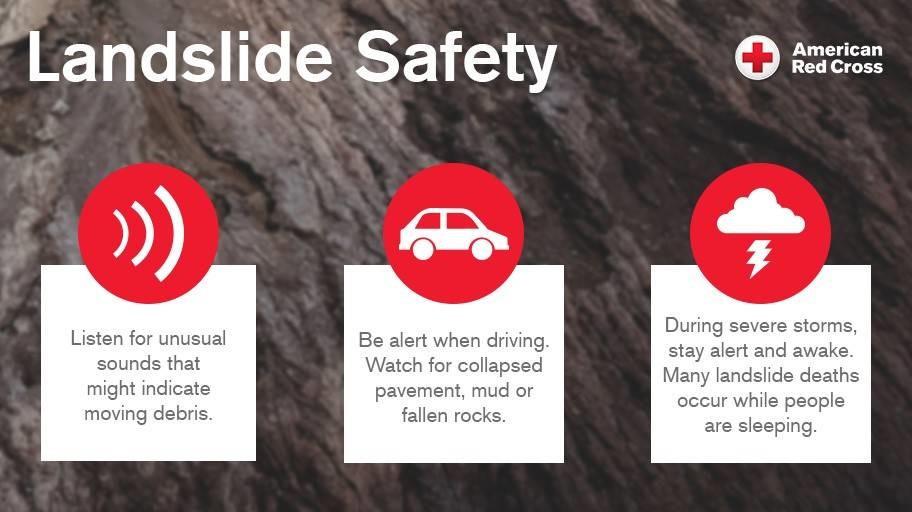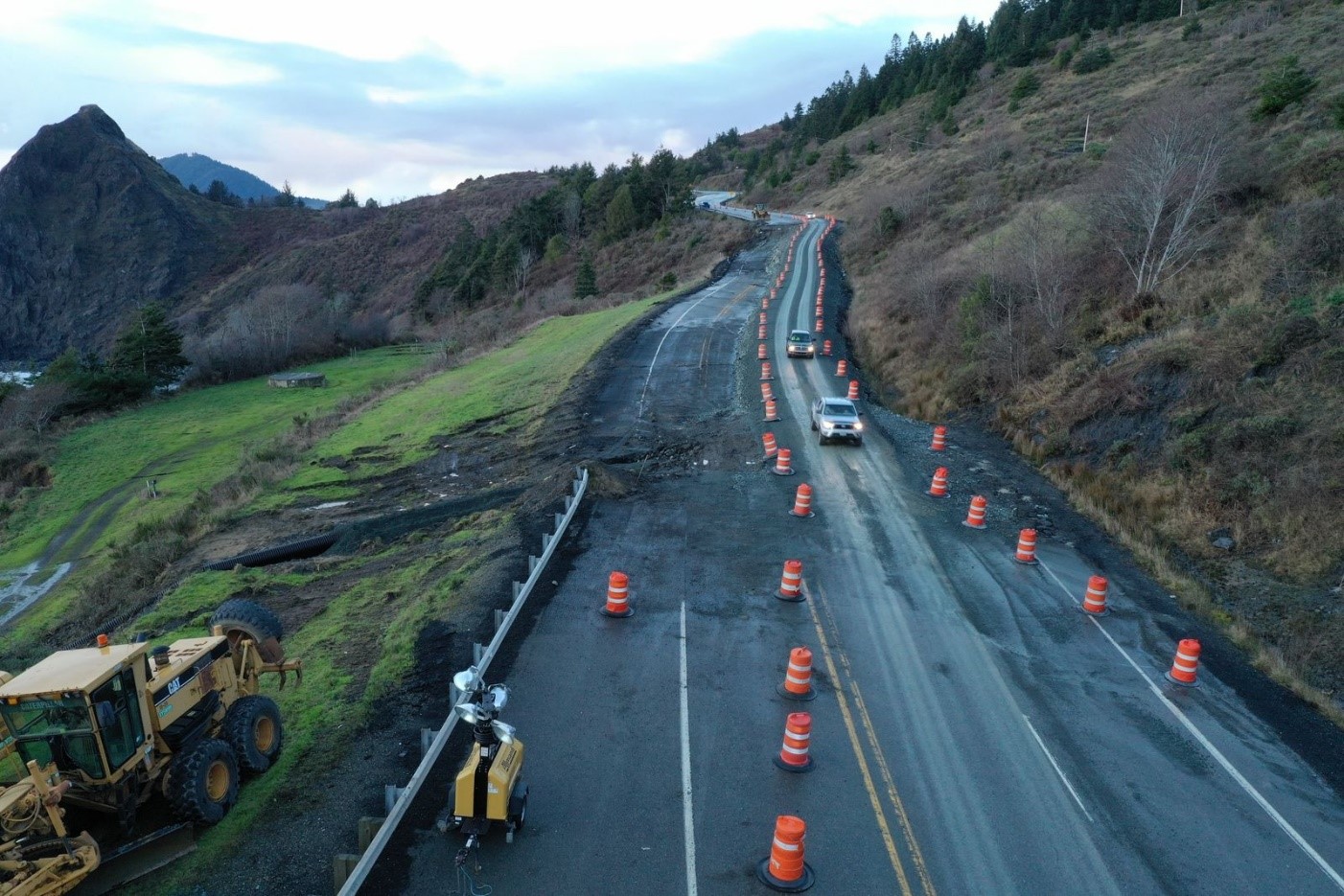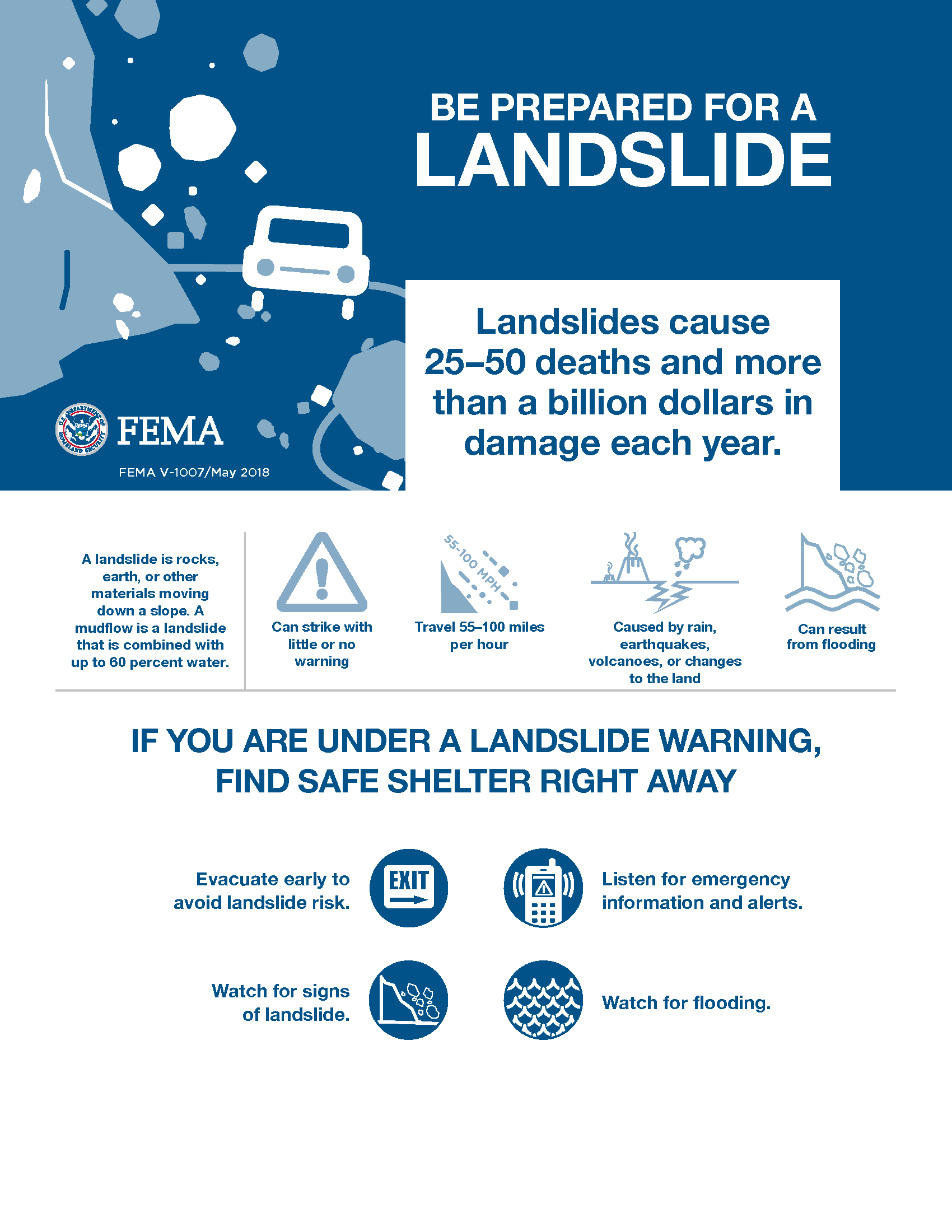Natural Disasters
Landslide Preparedness
One of the most crucial aspects of landslide preparedness is knowing the areas you frequent that are prone to this activity. Utilize the Statewide Landslide Information Layer for Oregon (SLIDO) Map linked below to check the susceptibility of your home, work, and other frequented spaces. Be on high alert in these areas during and after periods of heavy rain, wildfire, snow melt, earthquakes, or logging. Check ODOT’s tripcheck.com before traveling through prone areas.
You can often tell if an area is susceptible to landslide activity from just observing. Visual cues of landslide susceptibility include:
-
- Tilted and bent trees.
- Cracks in the ground or on paved areas.
- Ground bulging at the base of a slope.
- Lack of vegetation on a slope.
Landslides can severely damage infrastructure, potentially isolating western Lane County from outside assistance and supply chains. You should have an emergency kit at home with enough food, water, medicine, and other essential supplies to last 2 weeks. Click here to learn more about becoming 2 weeks ready. Also keep a go-bag in your car in case you need to evacuate or end up stuck on the road due to landslide activity. Keep a shovel, jack, or similar object in your car to help free your vehicle if you get stuck in mud.
Other Landslide Preparedness Tips:
-
- Have a communication and evacuation plan for your household.
- Sign up for LaneAlerts and other warning systems.
- Pay attention to weather forecasts and/or alerts when in susceptible areas.
- If you live on a slope or in a susceptible area, build channels or deflection walls to direct surface runoff around buildings and critical infrastructure.
-
- Make sure that the channels do not flow onto your neighbor’s property, or you may be liable for damages. Try to control water flow into existing storm drains or natural drainages[3].
-
- Consult local planning professionals, geologists, and land surveyors for advice on appropriate preventative measures for your property.
- Discuss landslide coverage with your insurance agents.
-
- Debris flow may be covered by flood insurance policies from the National Flood Insurance Program.
-
- Plant ground coverings and vegetation on sloped land.
During and After a Landslide
Warning signs of a landslide[4]:
-
- Sounds such as trees cracking, boulders knocking together, rushing water, mud trickling, or progressively louder rumbling.
- Fallen boulders in the area (sign of past debris flow).
- Small tumbling of rocks, dirt, or debris.
- Creek or stream water suddenly turning muddy with a sudden increase/decrease in water flow.
If you experience any of these warning signs, quickly leave the area.

Figure 3 – Landslide Safety, American Red Cross
During a Landslide…
-
- Stay alert for local news or weather updates on your phone or a battery-powered radio.
- Listen for and follow instructions from local emergency managers.
-
- Evacuate immediately if you are instructed to do so.
-
- Avoid low-lying areas, particularly creek beds or river valleys.
- If you get stuck in the path of a landslide, move uphill away from the flow as quickly as possible.
- DO NOT cross a road or path with water or mud flowing.
- Avoid bridges.
-
- Landslides move rapidly and can be much larger than they initially appear. Never assume a bridge is high or sturdy enough to protect you from a landslide.
-
- Seek higher ground[5].
-
- If you are in a building, move to the second story or higher.
- If you are outside, run to higher ground or seek shelter inside a building if possible.
-
- If your house begins to move with the landslide and you are unable to safely exit, move to a higher floor and close yourself in the bathroom.
- If you are caught in a landslide, keep moving and making noise to help responders find you[6].
- If you are in your car during a landslide, keep the doors shut and the windows rolled up. If possible, move out of the path of the landslide.
After a Landslide…
-
- Avoid the area of the slide.
- Stay tuned for updates from local officials.
- Stay alert for potential secondary hazards, particularly flooding.
- Report broken or damages power lines, roads, or other critical infrastructure to Florence Public Works, CLPUD, ODOT, or 911 if the damage threatens public safety.
-
- Click here for more information on reporting storm related issues.
-
- Replant ground coverings on damaged land as soon as possible to minimize the potential for flash flooding or future landslides.
Landslide Resources
- Landslide and Debris Flow, FEMA’s ready.gov
- Landslides, Oregon Health Authority
- Landslides, FEMA
- Simple Actions to Survive a Landslide, The Landslide Blog, Advancing Earth and Space Sciences Blogosphere
- Landslide Preparedness, USGS
Footnotes
[1] Unstoppable Slopes, Landslides, Debris Flows, and Rockfalls, Oregon Department of Transportation
https://www.oregon.gov/odot/pages/landslides.aspx
Areas also prone to landslides: U.S. 97 near Klamath Falls, roads in the Columbia River Gorge, and roads in the Cascade Mountain Range.
[2] Debris Flow and Landslide Warnings, Oregon Department of Geology and Mineral Industries (DOGAMI)
https://www.oregon.gov/dogami/landslide/Pages/debrisflow.aspx
[3] Oregon Geology Fact Sheet: Landslide Hazards in Oregon, Federal Emergency Management Agency (FEMA)
https://pubs.oregon.gov/dogami/fs/landslide-factsheet.pdf
[4] Landslides, Oregon Health Authority (OHA)
[5] Landslide Trapped, Federal Emergency Management Agency (FEMA).
https://community.fema.gov/ProtectiveActions/s/article/Landslide-Trapped
[6] Petley, Dave, Vice Chancellor of the University of Hull, Advancing Earth and Space Sciences Blogosphere


